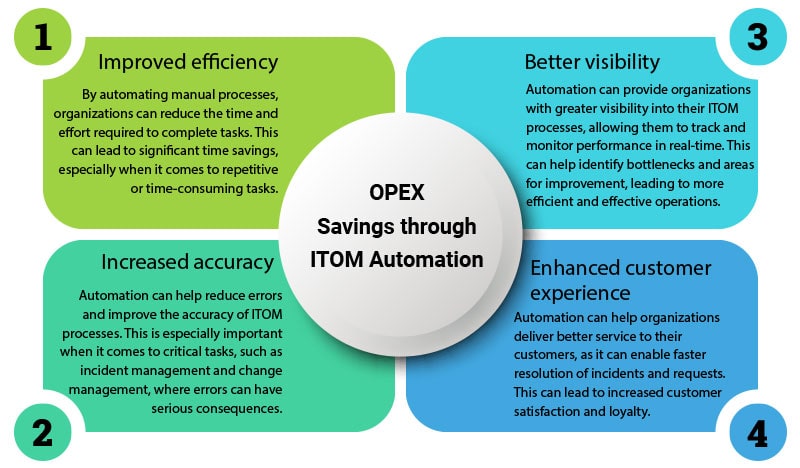In today’s fast-paced business environment, organizations always look for ways to streamline operations and reduce costs. One way to achieve these goals is through IT operations management (ITOM) automation, and there are few tools more powerful for this purpose than ServiceNow.
ServiceNow is a cloud-based platform that helps organizations automate and manage various ITOM processes, including incident management, change management, problem management, and service catalogue management. By automating these processes, organizations can save time, reduce errors, and improve efficiency – all of which can lead to significant cost savings.
In this blog, we’ll take a closer look at the potential cost savings that can be realized through custom ITOM automation using ServiceNow, and we’ll provide some tips on how to get started with this powerful tool.
Benefits of ServiceNow ITOM Automation
Before we dive into the specific cost savings that can be realized through ServiceNow ITOM automation, it’s important to understand the benefits of this approach in general.
Here are a few key advantages of automating ITOM processes

OPEX Savings through ServiceNow ITOM Automation
Now that we’ve discussed the general benefits of ITOM automation, let’s look at the specific cost savings that can be realized through this approach.
One of the primary ways that ServiceNow ITOM automation can lead to cost savings is by reducing operational expenses (OPEX). These are the ongoing expenses of an organization, such as wages, utilities, and supplies. By automating ITOM processes, organizations can reduce the time and resources required to complete tasks, leading to significant OPEX savings.
For example, consider a large organization receiving a high volume of incident and service requests daily. Without automation, these requests would need to be handled manually, requiring a team of IT staff to review and resolve them. With ITOM automation, however, many of these requests can be automatically routed and resolved, reducing the need for manual intervention. This can lead to significant time and labor savings, resulting in lower OPEX costs.
In addition to labor savings, ServiceNow ITOM automation can save costs by reducing errors and rework. When manual processes are prone to errors, organizations often need to devote additional time and resources to correcting those errors. By automating ITOM processes, organizations can reduce the number of errors, leading to fewer rework efforts and lower costs.
Now that we’ve discussed the general benefits of ServiceNow ITOM automation let’s look at the specific dollar savings that can be realized through this approach.
One of the primary ways that ITOM automation can lead to dollar savings is by reducing operational expenses (OPEX). These are the ongoing expenses of an organization, such as wages, utilities, and supplies. By automating ITOM processes, organizations can reduce the time and resources required to complete tasks, leading to significant OPEX savings.
For example, consider a large organization receiving a high volume of incident and service requests daily. Without automation, these requests would need to be handled manually, requiring a team of IT staff to review and resolve them. With ServiceNow ITOM automation, however, many of these requests can be automatically routed and resolved, reducing the need for manual intervention. This can lead to significant time and labor savings, resulting in lower OPEX costs.
In addition to labor savings, ServiceNow ITOM automation can also lead to dollar savings by reducing errors and rework. When manual processes are prone to errors, organizations often need to devote additional time and resources to correcting those errors. By automating ITOM processes, organizations can reduce the number of errors, leading to fewer rework efforts and lower costs.
Finally, ServiceNow ITOM automation can lead to dollar savings by optimizing resources. By providing organizations with greater visibility into their ITOM processes, automation can help them identify areas where resources are being underutilized
ITOM Automation in ServiceNow: Realizing Dollar Savings
IT operations management (ITOM) automation can provide organizations with numerous benefits, including improved efficiency, accuracy, visibility, and customer experience. In addition to these benefits, ServiceNow ITOM automation can also lead to significant dollar savings in operational expenses (OPEX).
So, just how much can be saved through the use of ITOM automation in ServiceNow? It isn’t easy to provide a one-size-fits-all answer, as the potential savings will depend on various factors, including the specific ITOM processes being automated, the size of the organization, and the current state of its IT operations. However, ServiceNow ITOM automation can lead to significant dollar savings in a few key areas.
Labor Savings
One of the primary ways that ServiceNow ITOM automation can lead to dollar savings is by reducing labor costs. By automating manual processes, organizations can reduce the time and effort required to complete tasks, leading to significant labor savings.
For example, consider a large organization receiving a high volume of incident and service requests daily. Without automation, these requests would need to be handled manually, requiring a team of IT staff to review and resolve them. With ServiceNow ITOM automation, however, many of these requests can be automatically routed and resolved, reducing the need for manual intervention. This can lead to significant labor savings, as the IT staff can be redeployed to more value-added tasks.
Error and Rework Reduction
Another area where ServiceNow ITOM automation can lead to dollar savings is reducing errors and rework. When manual processes are prone to errors, organizations often need to devote additional time and resources to correcting those errors. By automating ITOM processes, organizations can reduce the number of errors, leading to fewer rework efforts and lower costs.
For example, consider an organization that uses manual processes for change management. Without automation, there will likely be a certain number of errors and miscommunications that result in the need for rework. With ITOM automation in place, the risk of errors is significantly reduced, leading to fewer rework efforts and a corresponding reduction in labor and other costs.
Resource Optimization
Finally, ServiceNow ITOM automation can lead to dollar savings by optimizing resources. By providing organizations with greater visibility into their ITOM processes. Automation can help them identify areas where resources are underutilized or overutilized. By adjusting resource allocation accordingly, organizations can improve efficiency and reduce waste, leading to significant dollar savings.
For example, consider an organization with an IT team dedicated to managing incident and service requests. Without automation, it may be difficult for the organization to gauge the workload accurately. Leading to either underutilization or overutilization of resources. With ITOM automation in place, however, the organization can track and monitor the workload of this team in real time, ensuring that resources are being utilized optimally.
Conclusion
In conclusion, ServiceNow ITOM automation with ServiceNow can lead to significant dollar savings by reducing labor costs, reducing errors and rework, and optimizing resources. The exact amount of savings will depend on various factors. Still, by automating ITOM processes, organizations can improve efficiency, increase accuracy, and reduce waste, all of which can translate into significant cost savings.













